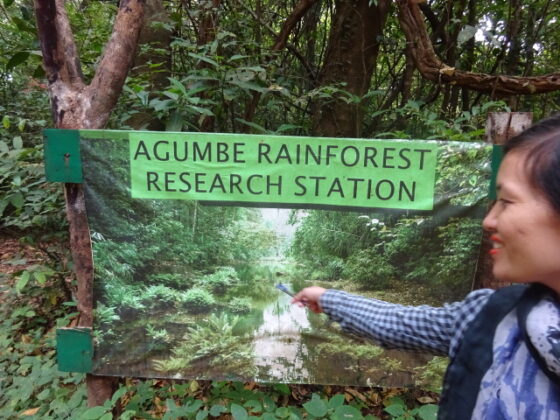Table of Contents
Situated in the taluka of Thirthahalli of Shimoga district in Karnataka, India, Agumbe is a settlement. This is in a thick forest of Malenadu region of the mountain range of the Western Ghats. This has been termed as the ‘Cherrapunji of South India’ due to the heavy rainfall it receives. As known, Cherrapunji is a place receiving the heaviest rainfall.
Agumbe is associated with the efforts of conservation of rainforests, tourism, documentation of plants considered as medicinal and also cottage industry promotion. The Agumbe Rainforest Research Station (ARRS) was a sanctuary for the King Cobra, one of the flagship species of Agumbe.
Size
Agumbe is a small village with limited accommodation for visitors. The population of this place is only around 500 people. This village covers only 1.2 sq mi (3 square kilometers.
Location
Agumbe located in the district of Shivamogga, is on the south-west coast of India, around 61 mi (98km) morth-east of Mangalore and 222mi (357km) north-west of Bangalore, that is the capital of the Karnataka state in South India. The nearest ralway station is Udupi, a coasal town. The closest airport is Bajpe close to Mangalore. This is at a distance of around 58mi (94km). Agumbe ‘s elevation is around 2,700 ft (823m). This is in the World Heritage site of the UNESCO as part of the mountain range of the Western Ghats. Agumbe is close to the Wildlife sanctuary of Someshwara and also the Kudremukh National Park.
History and Culture of Agumbe
Agumbe is considered to be the most scenic hill stations of Karnataka. The waterfalls are the major attraction here. Besides this, you can also look forward to the forest trails and the spectacular sunset. The highest rainfalls received here is totally worth an experience.
Malgudi Days, one of the popular serials of th television, that was directed by Shankar Nag, were shot in Agumbe. This is around 55km from the Arabian Sea. This is one of the last-surviving rainforests. In 1999, MPCA (Medicinal Plants Conservation Area) was established here for protecting the important medicinal plants. The annual rainfall here is, almost 7,640 mm.
The different species of medicinal plants found in Agumbe include Myristica, Garcinia, Diospyrous, Listsaea, Holigama, Eugenia and also Ficus among the others. This is also termed as ‘Hasiru Honnu’. This means, ‘green is gold’.
The reserve forest and the whole surrounding area around Shankarnarayana, Kundapur, osanagara, Thirthahalli and Sringeri are referred to as the ‘Agumbe Rainforest Complex’ collectively. During the monsoons, the surrounding area along with Agumbe are alive with a numbr of waterfalls. Some of these are Barkana Falls, Kunchikal Falls, Jogigundi Falls and Onake Abbi Falls.
Most of the tourists visiting Agumbe, come for trekking through the forests, or for visiting the waterfalls. Trekking to Nishani Gudda or Kudlu Theertha Falls is once in a life-time experience. All you need to do is be cautious about the leeches present in these forests.
The visual treats offered by Agumbe can be termed as the ‘high points’ of the trek. You can also enjoy the gallery that has been erected to view the sunset at the Sunset Point.
ARRS (Agumbe Rainforest Research Station)
The ARRS is a field station that is permanent. This is of the Crocodile Bank Trust of Madras and is located in a site of 4.5 acres. This is in the middle of theAgumbe Reserve Forest and Someshwara Wildlife Sanctuary. Renowned herpetologist, Romulus Whitaker founded the ARRS in the year 2005. The financial supports were given by the Whitley Fund for Nature and the late Doris Norden Chattopadhyaya. The mission was to conserve rainforest through applied research of ecology and also study. The research and the administration team have 4 people and 6 of the employees are from the local community.

ARRS has hosted and initiated studies on different subjects related to ecology, this includes studies on King Cobra Telemetery Project. This was the first of the kind in India. ARRS is also affiliated with a number of different conservationists and scientists from organizations around the world. The aim of this organization is to further the research cause through this field station considered ‘unique’.
Within the Central Western Ghats at 650 meters elevation Agumbe is known to have a tract that is distinctive of moist, tropical, evergreen forest. The forests that are around Agumbe, after almost a century of logging selectively, drenched by 7,500 mm of rainfall every monsoon, have managed to regenerate over 35 yars and are teeming with life. To date, at ARRS, 45 reptiles, 32 mammals, 31 amphibians, 130 butterflies, 202 birds and a number of plant species have been recorded.
ARRS works out as an ideal location for different research, this range from population and behavioral ecology, rainforest ecology, phenology, hydrology, geo-informatics, canopy studies and also socio economics. The locals of Agumbe depend on these forests for their livelihoods. These villagers can be considered as repositories of traditional knowledge. This provides for a lot of research of social science and cement the communities locally involvement at ARRS.
Reasons for Visiting Agumbe
There are many reasons for including Agumbe in your next itenary.
Treks: You can enjoy trekking with different groups, either in the monsoons o even post-monsoon. These groups who are familiar with Agumbe can help you witness rare species of snakes, frogs, insects and also flora and fauna.
Hairpin Bends: Climbing requires you to negotiate almost 14 hairpin bends. These bends are steep and trucks and buses are not allowed.
Waterfalls: Within only 5kms radius you can experience number of waterfalls untouched. These can be accessed by road for a short distance and then you need to walk.
Boating and Lake: Near the check post of the forest there is a small lake where you can get the boating facility.
How to Reach Agumbe
You have the choice of either flying to Mangalore and then take the road as Agumbe is only 100 kms from here.
You can also take a train to Shivamogga or Mangalore.
From Bangalore you can take a KSRTC bus if you wish to enjoy the road trip.
Why is Agumbe famous
Is Agumbe worth visiting
Why Agumbe is called Cobra capital
How do I plan for Agumbe trip





























